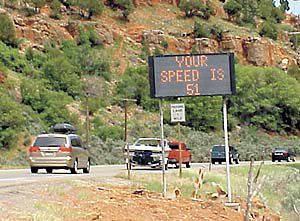| A traffic signs monitors the speed of eastbound motorists traveling along U.S. Highway 6 near the Tucker rest area. Installed by the Utah Department of Transportation, the solar powered sign at “Apple Bend” was operational and tracked vehicle speeds during the Memorial Day weekend. |
The Utah Department of Transportation announced on Tuesday that the agency has installed warning signs along U.S. Highway 6 near the Tucker rest area at milepost 203 and at “Apple Bend,” milepost 192.
Both sites have historically proved to be prone to accidents and are among the sharpest curves in the canyon between Spanish Fork and Price.
In August 2005, a semi-truck carrying 38,000 pounds of explosives tipped at Apple Bend, rolling the vehicle and trailer and setting off an explosion that closed the canyon for 36 hours.
The driver, Travis Stewart, was charged with misdemeanor counts of causing a catastrophe, reckless endangerment and reckless driving.
On May 24, a second explosion closed the canyon when a tanker truck hauling unleaded fuel rolled at virtually the same site.
“The problem we’re having seems to be the trucks,” said Nile Easton, a spokesperson for UDOT.
The solar powered sign at Apple Bend was operational for Memorial Day weekend.
Speed sensors activate the display when a driver approaches the curves at speeds in excess of 45 miles per hour.
The sign will flash the vehicle’s speed and warn the driver to slow down.
The second sign is in place near the rest stop and is set to be operational within the next two weeks. Cost for the two signs is approximately $58,000.
Both signs are set for only eastbound traffic.
“There is a history of rollovers in eastbound traffic,” said Easton.
And while collisions have occurred in both directions, Easton confirmed that there are currently no plans to install similar signs for westbound traffic.
The decision to post warning signs for eastbound traffic and not for westbound traffic goes back years to decisions made regarding the placement of signs at Apple Bend.
Both curves have S-curve warning signs with 40 mph advisory speeds.
However, an additional 90 degree turn warning sign warns eastbound drivers of the sharp curve at Apple Bend, a sign that is absent for westbound drivers.
“I think people going down [the canyon] naturally brake more,” said Easton.
The UDOT representative said the immediate problem relates to semis taking the turns at high speeds and rolling.
The cost for the two new signs is a trifle compared to the cost of accidents at the two locations.
The explosion last August left a crater about 70 feet wide and 35 feet deep.
Costs of repairs stemming from the 2005 incident had been initially estimated between $100,000 and $200,000.
However, final figures estimate that the total cost was $600,000.
UDOT paid $180,000, with other government agencies absorbing the rest of the costs.
UDOT has demonstrated that U.S. Highway 6 is a priority for the department, dumping $110,000 in improvements into the highway over the past decade.
Still, the state transportation commission and legislature have kept projects such as Legacy Highway and carpool lanes on Interstate 15 at the top of its priority lists.
That sentiment was demonstrated earlier in the year when the transportation committee, comprised of state senators and representatives, voted against a measure that would have allowed the state to bond for $1.3 billion that would have been earmarked exclusively for improvements between Spanish Fork and Green River.
Easton stated that the department of transportation is continuing the agency’s study into the best ways to warn drivers traveling on the canyon road to slow down.
During the next few months, the UDOT representative indicated that state transportation officials will look at how the signs are working.
UDOT may possibly add more warning signs where needed, concluded Easton.

